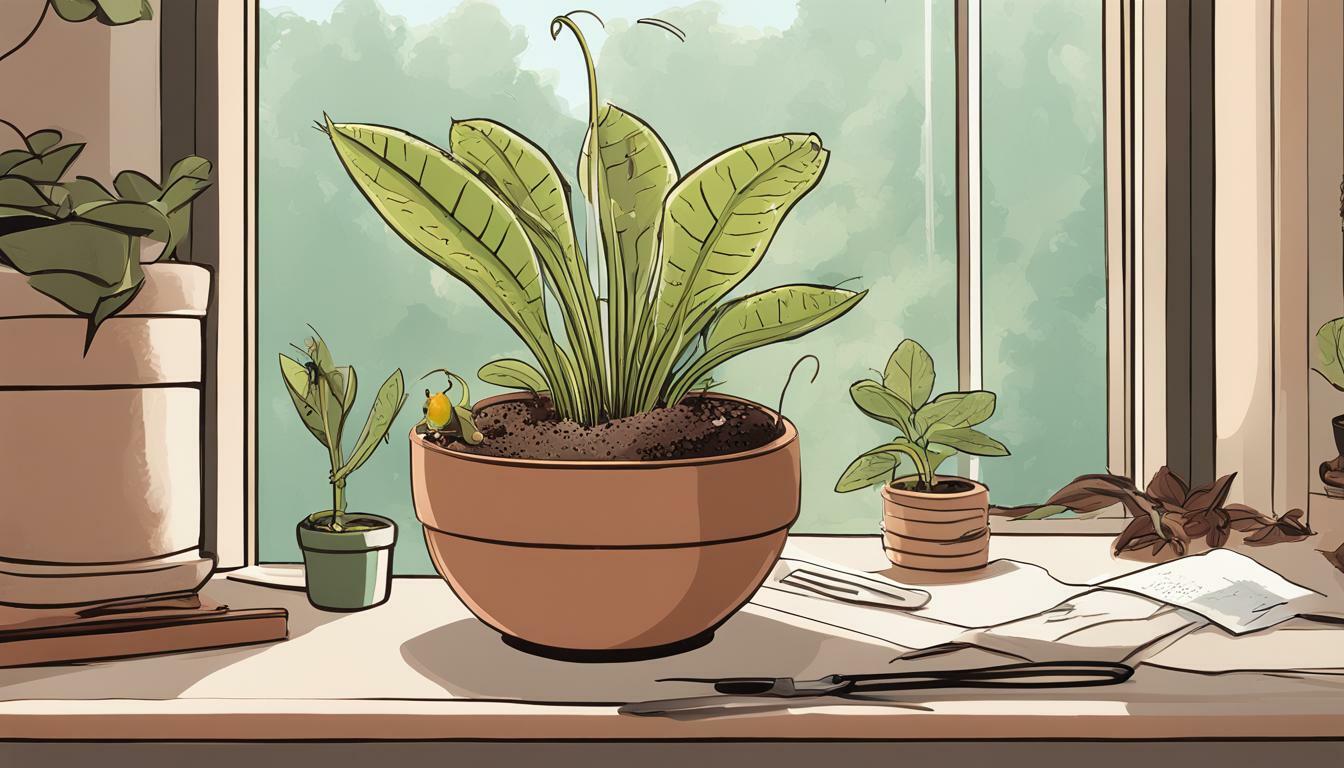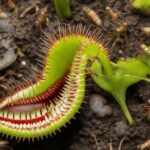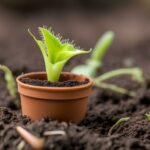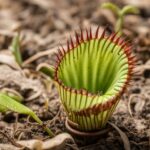If you’re the proud owner of a Venus flytrap, you’ve likely wondered how to feed it properly while keeping it indoors. This carnivorous plant requires specific care to thrive, including proper feeding techniques. In this section, we will provide tips and guidance to ensure your Venus flytrap remains healthy and well-fed.
Key Takeaways:
- Feeding a Venus flytrap indoors can be tricky, but with proper care and technique, it can be done successfully.
- Venus flytraps require specific environmental conditions to thrive, including proper lighting, temperature, and humidity levels.
- Feeding frequency, prey options, and method are all important factors to consider when feeding your Venus flytrap.
- Proper watering and hydration are crucial for the health of your Venus flytrap.
Understanding Venus Flytrap Care
Before you start feeding your Venus flytrap, it’s important to understand the basic care requirements. Venus flytraps are unique and fascinating carnivorous plants that require specific growing conditions to thrive.
The ideal conditions for indoor Venus flytrap care include bright, direct sunlight for at least four hours a day, moderate to high humidity levels of 50-70%, and temperatures between 70-80°F during the day and 55-65°F at night.
When caring for your Venus flytrap, it’s important to avoid tap water as it contains minerals that can harm the plant. Instead, use distilled water or rainwater to keep the soil moist. Avoid letting the soil dry out, but also ensure there isn’t any standing water in the pot as Venus flytraps require a well-draining soil mix.
If you’re unsure about the humidity or temperature levels in your home, consider investing in a digital thermometer or hygrometer to monitor the conditions. You can also use a tray of water and small stones to increase humidity levels around your plant.
Feeding Venus Flytraps: Best Practices
Feeding a Venus flytrap can be both fascinating and rewarding, but it is essential to do it correctly to ensure your plant’s health. Keep in mind that Venus flytraps feed on insects, not just any plant food or fertilizer.
The first and most important rule of feeding Venus flytraps is to avoid overfeeding as it can lead to the plant’s death. Feed your Venus flytrap only one or two insects per week. It’s always better to underfeed than overfeed, and if in doubt, wait a few extra days before feeding again.
When it comes to choosing the right prey, it’s best to opt for smaller insects such as fruit flies or gnats. Avoid feeding your Venus flytrap ants, bees, or any insects larger than 1/3 of the trap’s size, as they can overpower the plant and even damage it.
It’s also crucial to ensure the insect is alive and moving; otherwise, the plant may not detect it and begin digestion. When placing the insect inside the trap, make sure it’s positioned in the center of the trap, triggering the tiny hairs inside. Avoid touching or triggering the inside of the trap with your fingers, as this can damage the sensitive trigger hairs.
Once the trap has closed around the insect, it’s critical to be patient and let nature take its course. Do not force the trap open or remove the insect prematurely, as this can disrupt the plant’s digestive process. Allow the trap to open naturally when digestion is complete, usually after a few days to a week.
In summary, feeding Venus flytraps requires patience, attention to detail, and adherence to best practices. Remember to avoid overfeeding, opt for small insects as prey, and position them correctly inside the trap. With these tips in mind, you can enjoy watching your Venus flytrap thrive and grow.
Watering and Hydration Needs
Along with feeding, proper watering and hydration are essential for the health of your Venus flytrap. This carnivorous plant has specific requirements for moisture, and inadequate watering can lead to significant damage.
First and foremost, always use distilled water or rainwater when watering your Venus flytrap. Tap water is too alkaline and contains minerals that can harm your plant.
The amount and frequency of watering depend on the size of your Venus flytrap and the environmental conditions in your home. As a general rule, water your plant every three to four days, or when the soil feels dry to the touch. Avoid letting the soil become too dry or too wet, as both can cause damage to the roots.
When watering, make sure to use a tray or saucer underneath the pot to catch excess water. Do not allow the plant to sit in standing water, as this can lead to root rot. Instead, pour any excess water out of the tray after a few minutes.
Overall, proper watering and hydration are crucial for caring for your Venus flytrap. By using distilled or rainwater, watering regularly but not excessively, and ensuring proper drainage, you can help your plant thrive as part of your indoor plant collection.
Conclusion
Feeding and caring for a Venus flytrap indoors can be a fascinating and rewarding experience. By following the guidelines discussed in this article, you can successfully care for your unique plant in your home.
Remember to provide the proper environmental conditions, including adequate lighting, temperature, and humidity levels. Make sure to feed your Venus flytrap appropriately and avoid overfeeding or feeding it harmful prey. Lastly, ensure proper watering by using distilled or rainwater and avoiding common watering mistakes.
With proper care, your Venus flytrap will thrive as a captivating addition to your indoor plant collection. So go ahead, give it a try, and enjoy the wonder of this amazing carnivorous plant!
Can Venus Flytraps Survive Indoors Without Feeding Them?
Can Venus Flytraps survive indoors without feeding them? Venus flytraps indoors: the facts are that although they can technically survive without being fed, it is not recommended. These carnivorous plants rely on insects for essential nutrients. Without proper food, they may weak and eventually die. It’s crucial to mimic their natural environment as closely as possible to ensure their health and longevity.
FAQ
Q: How often should I feed my Venus flytrap?
A: Venus flytraps typically only need to be fed once every 2-4 weeks.
Q: What types of prey should I feed my Venus flytrap?
A: Venus flytraps are primarily carnivorous and thrive on live insects such as flies, ants, and spiders.
Q: How do I feed my Venus flytrap without harming it?
A: It’s best to gently place the prey near the trap’s open jaws, avoiding triggering any unnecessary movements that could damage the plant.
Q: Can I feed my Venus flytrap by hand?
A: While it is possible to feed your Venus flytrap by hand, it is not recommended as it can potentially damage the delicate traps.
Q: Should I remove dead prey from the traps after feeding?
A: It is generally best to allow the traps to digest the prey naturally. However, if the prey is exceptionally large or causing the trap to remain closed for an extended period, it can be carefully removed to prevent rot.
Q: How do I know if my Venus flytrap is hungry?
A: When hungry, Venus flytraps will produce a distinctive scent and display open traps. Closed traps typically indicate that the plant is not hungry or digesting prey.
Q: Can I use tap water to water my Venus flytrap?
A: No, tap water often contains minerals and chemicals that can harm your Venus flytrap. It is best to use distilled or rainwater to water your plant.
Q: How often should I water my Venus flytrap?
A: Venus flytraps prefer to be kept consistently moist. Water them thoroughly every 1-2 weeks or when the soil begins to dry out.
Q: Can I mist my Venus flytrap instead of watering it?
A: Misting can be beneficial to increase humidity, but it should not replace regular watering. Venus flytraps still require proper watering to stay hydrated.










